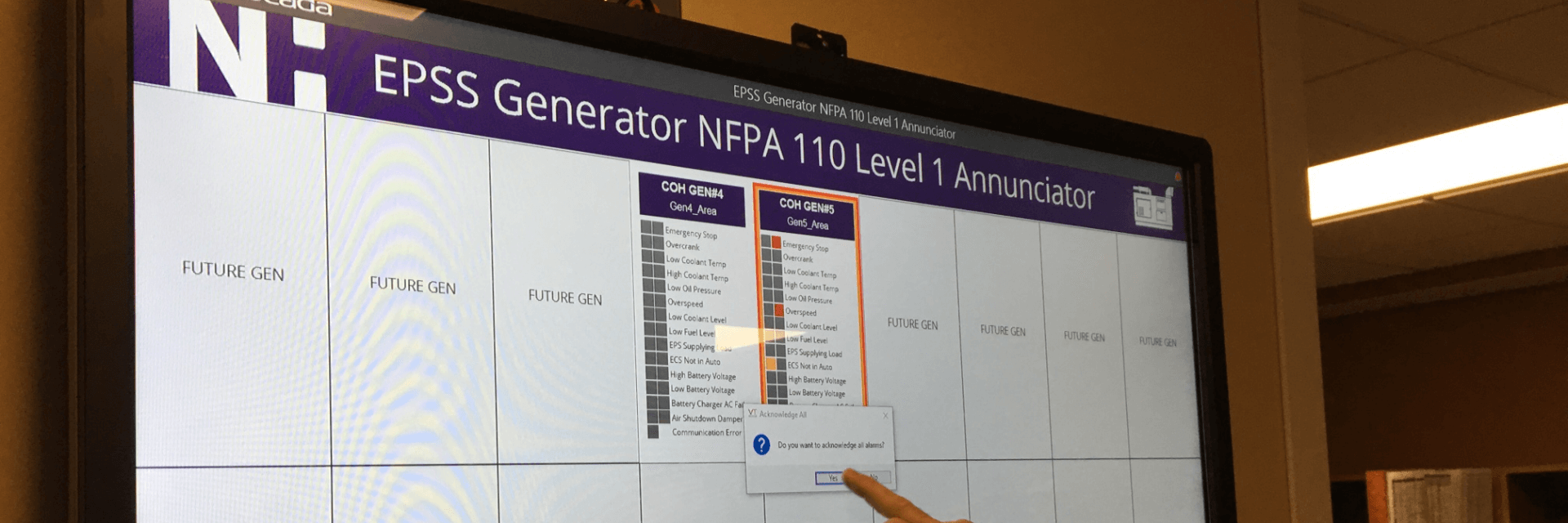Novant Health and Carolina CAT seek help in an emergency generator audible alarming compliance situation. (Read part 1)
Novant Health
Novant Health Presbyterian Medical Center is a nonprofit 622-bed tertiary medical center in Charlotte, NC. As a Level 1 facility, their generators are required to comply with National Fire Protection Association (NFPA) 110 standards.
According to NFPA 110, a standard for inspecting and testing emergency generators, all Level 1 generators (generators that could result in the loss of life or serious injury, should they fail) must have remote visual and audible alarming to alert personnel to the presence of generator safety and shutdown indications.
The standard states: “The minimum remote alarm annunciation is to alert personnel at a constantly attended station somewhere on the site when the facility is in use as a Level 1 system. If the site is not continuously occupied, ‘network remote’ should allow people at another site to know the operating status of the equipment.”
What Our Clients Say About Us
There aren’t too many companies who would have been able to answer our SOS at the drop of a hat, especially without much previous experience with Deep Sea and Baseler generator control panels. But Affinity Energy is one of them.
Jerry Beavers
Carolina CAT
Challenge
On a Wednesday afternoon in March 2018, Novant Health was cited in a DHSR (Division of Health Service Regulation) audit because the remote annunciator for the D-wing generator failed to produce an audible alert when tested. If not fixed in 48 hours, they faced a $25,000 per day fine.
Novant Health and their generator partner, Carolina CAT, called Affinity Energy that same evening to ask for assistance and expedite a proposed project to upgrade the existing NFPA remote annunciators. Affinity Energy engineers visited Novant that evening to verify communications to the existing Deep Sea DSE 8710 generator control panels using Modbus TCP on the hospital network. Since all the generators had this control panel and were already on the network, the path was cleared for integrating existing generators.
Solution
Over the next two days, and with Carolina CAT’s help, Affinity Energy engineers built and tested Deep Sea DSE 8710 integration with the NFPA touchscreen annunciator panel originally created by Affinity Energy in a previous project for Novant, and integrated the remaining 14 of Novant Health’s generators.
Originally, Affinity Energy integrated two Caterpillar EMCP 4.2 generators into the NFPA annunciator panel, but because the remaining 14 generators used Deep Sea DSE 8710 control panels, Affinity Energy had to build an entirely new template for the annunciator panel.
By the end of the 48-hour grace period, Affinity Energy’s touchscreen annunciator panel solution displayed all Novant generators, and Carolina CAT technicians had fully tested the failed D-wing generator annunciation for DHSR approval.
Results
After demonstrating the D-wing annunciator solution, Novant Health asked the DHSR for a 30-day extension to make additional control upgrades.
While integrating Deep Sea DSE 8710 control panels into the remote annunciator panel, Carolina CAT and Affinity Energy determined some of the alarms required by NFPA 110 Level 1 were not integrated into the Deep Sea control panels. Providing the missing alarms would require re-programming of the DSE 8710 control panels.
However, due to the customer’s negative history with the failed Deep Sea annunciator product and lack of timely customer support, they sought to upgrade and retrofit the existing generator control panels, as well as incorporate the following features into the Affinity Energy remote annunciator panels:
- Alarm rearming after user acknowledgement to reengage the siren and require operator intervention.
- Alarm emails that not only allow alarm viewing at the panel, but the ability to email alarm details to on-call personnel and management.
- A second, independent control panel installed in a different building.
The proposed solution would involve Carolina CAT replacing all Deep Sea 8710 control panels with either Basler DGC-2020 Digital Genset Controllers or Caterpillar EMCP 4.2 Generator Set Controllers and Affinity Energy upgrading the capabilities of the existing remote annunciator panel, developing a Basler DGC-2020 template, and installing a second independent panel in plant engineering.
After Novant Health agreed, Carolina CAT and Affinity Energy mapped out a plan to upgrade the control panels and test the remote annunciator for 13 of the 14 generators. (One of the 14 generators was a temporary generator and scheduled to be removed within several weeks.) In the end, Carolina CAT staffed the project and worked some incredible hours to meet the 30-day deadline, which involved not only installing new panels, but testing alarms at the remote annunciator panel at switchboard operations and plant engineering.
Now that Novant Health has a direct interface to each generator’s control panel through smart communications, the next step is to demonstrate automated Joint Commission reporting using real-time status and generator readings from the generator control panels.
Related Success Stories
Novant Health Presbyterian Medical Center: NFPA 110 Generator Audible Alarming
Novant Health and Carolina CAT seek a new generator audible alarming solution to simplify NFPA compliance for the addition of new engine-generators by developing a functional solution that minimized…
Southeast Hospital System – Portfolio Audible Alarming
In 2016, a large hospital system in the Southeast with multiple Central Energy Plants (CEP) chose Affinity Energy to implement an audible alerting functionality into their previously existing…


